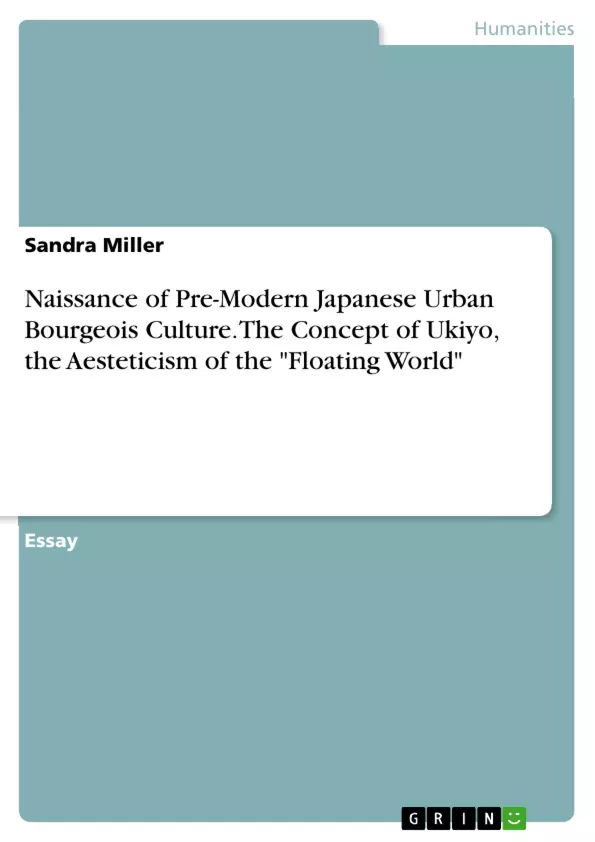Unprecedented concentration and tremendous social influence were the two intrinsically linked phenomena that characterized the Edo period (1603-1868). Firstly came the rise of urban centres, in particular Edo, Kyoto and Osaka and secondly, a new social strata that developed within these cities. The two events of an urban concentration and a prosperous bourgeoisie – the chōnin, a combination of artisans and nouveau-riche merchants – were elemental for the expansion of segregated and licensed pleasure quarters offering every form of amusement, but which were then subjected to close governmental supervision.
There were two reasons for control: Firstly, to fight subversion; and secondly, to keep public morals in check. The latter became necessary when, as the standard of living had gradually improved for the general urban population, the demand for leisure activities and entertainment opportunities had increased accordingly. Shōgun (the hereditary military governor military leader equivalent to the rank of general), daimyō (hereditary feudal lords) and samurai or bushi (military nobility) had always spent their money in the city, especially in Kyoto, but now entertainment possibilities extended to the prospering middle-class, who strove to establish a mode of life that would reflect their newly established economic importance; they wanted to enjoy life according to their wealth. Chōnin found opportunity for self-assurance by conspicuous consumption of ephemeral pleasures within the ‘floating world’ – a euphemism for the licensed pleasure quarters – where money reigned supreme and everybody was able to take on a role in accordance to his means.
Inhaltsverzeichnis (Table of Contents)
- INTRODUCTION
- 1. The New Aestheticism of the Chōnin Class
- 2. The Rise of Pleasure Districts in Edo, Kyoto and Osaka
- 3. Emergence of a New Culture: Ukiyo - The World of Pleasure
- 4. The Cultural Significance of the Pleasure Districts
- 5. Escapism from Propriety
- 6. The Ethic and Economic Power of the Chōnin Class
- 7. The Dandy in the 'Floating World'
- 8. CONCLUSION
Zielsetzung und Themenschwerpunkte (Objectives and Key Themes)
This text explores the rise of pre-modern Japanese urban bourgeois culture, specifically focusing on the "ukiyo" (Floating World) aestheticism of the Edo period (1603-1868). It examines how the development of urban centers and a burgeoning merchant class – the chōnin – led to the emergence of segregated pleasure quarters and a new culture of leisure and consumption.
- The rise of the chōnin class and its impact on Japanese society
- The development of pleasure districts as centers of urban culture
- The concept of "ukiyo" and its evolution from Buddhist philosophy to a cultural phenomenon
- The aestheticism of the Floating World and its influence on artistic and social trends
- The role of licensed pleasure quarters in shaping a new urban identity
Zusammenfassung der Kapitel (Chapter Summaries)
The introductory chapter establishes the context for the text by highlighting the significant population growth and the emergence of a prosperous merchant class during the Edo period, leading to the development of pleasure districts. The first chapter delves into the aestheticism of the chōnin class, exploring their unique values of sui, iki, and tsū, as well as their role in the rise of kabuki theater and the Yoshiwara pleasure district in Edo.
Chapter two discusses the development of pleasure districts in major cities like Edo, Kyoto, and Osaka, analyzing the rationale behind governmental supervision and control. The chapter examines the different approaches to regulating pleasure districts, including physical confinement, licensing, and the role of rōnin in these environments.
Chapter three focuses on the emergence of "ukiyo" as a new cultural phenomenon, tracing its shift from a Buddhist concept to a celebration of pleasure and entertainment for the middle class. It also examines the influence of the upper strata of society on early entertainment quarters and the eventual transition to a culture driven by the chōnin.
Schlüsselwörter (Keywords)
The key terms and concepts explored in this text include the chōnin class, ukiyo (Floating World), Edo period, pleasure districts (Yoshiwara, Shimabara, Shinmachi), kabuki theater, sui, iki, and tsū, and the role of entertainment in shaping urban identity and social change.
- Arbeit zitieren
- Sandra Miller (Autor:in), 2006, Naissance of Pre-Modern Japanese Urban Bourgeois Culture. The Concept of Ukiyo, the Aesteticism of the "Floating World", München, GRIN Verlag, https://www.hausarbeiten.de/document/293520


